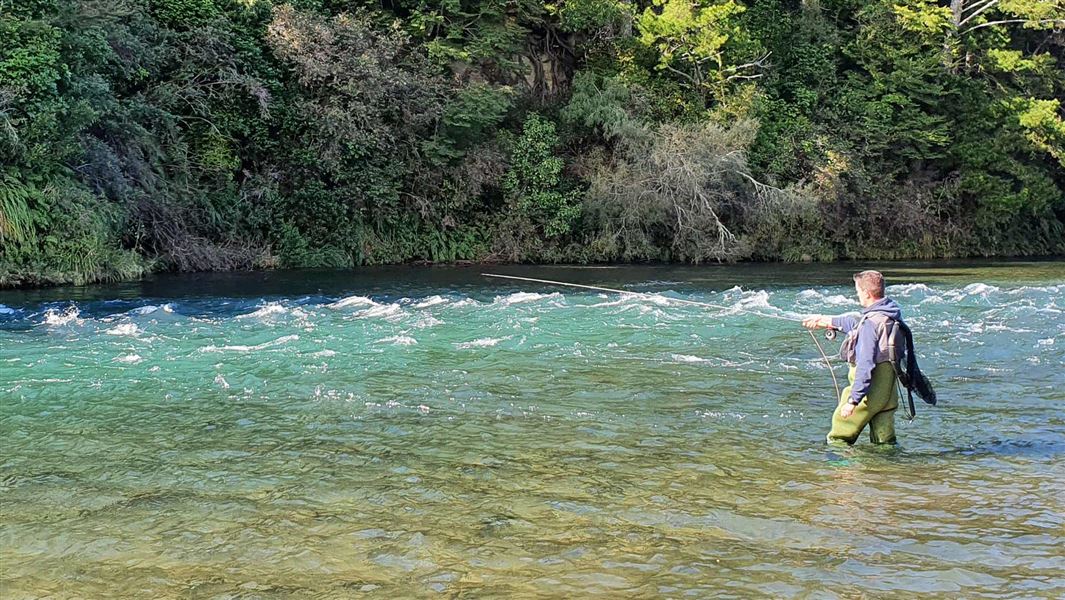Introduction
Czech or Euro nymphing is a typical example of how fresh thinking can push the boundaries of conventional fly fishing, opening a new way to catch trout. Originating from successful European teams competing in the World Fly-fishing Championships, this short line nymphing technique is an effective and engaging way to catch trout that requires the angler to be focussed and mobile.
While it can be a great technique for catching high numbers of trout, it has limitations and should be viewed as another tool in the trout angler’s toolbox.
The technique includes:
- stealthy, active approach
- extensive wading
- longer rods and lighter gear
- any time of year
- weighted or slim profile flies
- barbless hooks.
Approach
This technique requires the angler to actively move through pools and runs, holding the fly rod high with a relatively short length of line running from the rod tip directly to the flies. This direct contact with the flies often allows the angler to feel them and quickly detect when a trout intercepts the fly. In addition, a small section of coloured line can be used to provide a visual indication of a ‘take’.
Casting in the traditional sense is not required, instead the angler uses a wrist motion to flick or gently lob the flies ahead of a likely looking ‘run’ and uses the rod tip to follow and maintain contact with the flies as they move downstream. Fishing often takes place within a few metres of the angler, so a stealthy approach is important. The technique can be adapted for larger rivers such as the Tongariro, allowing the angler to extend their reach.
Typically, this technique requires flies to drop quickly through the water column to reach feeding trout, so they are often weighted or have a thin profile. Once the basics are understood anglers can explore variations that increases the flexibility of this method.
Gear
A conventional fly rod and a reel containing fly line is required in the Taupō Fishing District. Many anglers simply use their usual 5 or 6 weight nymph rods, but a dedicated long and light rod such as a 10 foot, aftm 4 weight, with a sensitive tip and strong butt section can deliver better results. The longer length allows for increased reach and greater control of the flies, a sensitive rod tip offers improved feel and bite detection and a stronger butt section gives a better chance of landing larger Taupō trout. Ideally the reel will balance the rod and possess a smooth drag system, allowing it to cope with strong trout at close quarters.
Taupō fishery regulations state the reel must be loaded with at least 3 m of fly line, while the leader and tippet section must be no longer than 6 m in length.
The increase in popularity of this approach has spawned a host of dedicated lines and specialist leaders. As a guide, the fly line should be as light as possible to reduce potential drag on the flies and the transition between fly line and leader should be smooth. Leaders can vary in construction but usually involve a long section of heavy line (10–12 lb) connected to a high-viz sighter material, which in turn connects to the tippet and flies. The whole leader and tippet should not exceed 6 m.
A selection of tungsten bead trout flies in different weights enables the angler to adapt to different conditions and these can be paired with a variety of slim profile patterns. Split shot can be used to add additional weight if required but can significantly reduce the effectiveness of this technique.
Anglers will spend considerable time in the water carefully covering likely spots, so lightweight waders, a wading belt and a good wading staff can be invaluable.
Depending on the time of year and location, a significant proportion of juvenile trout may be caught. This increases the need for catch and release and elevates the benefits of barbless hooks.
Many local fishing stores now carry a good selection of specialist Czech/Euro nymphing gear and will be happy to tailor a setup to your specific needs and budget.
Look out for an upcoming ‘How to fish’ video along with a detailed article helping to demystify this technique.
